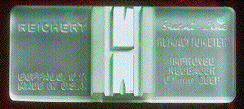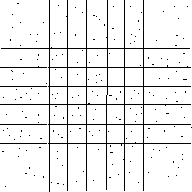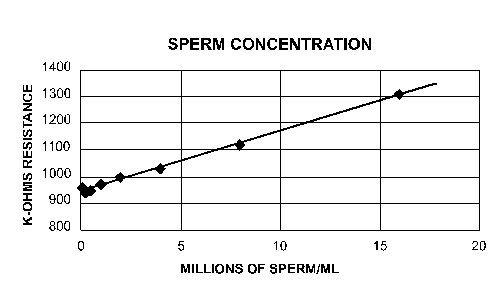- make serial dilutions
- make readings with a spectrophotometer
- count sperm under the microscope using a hemacytometer
- keep careful notes
- graph results on linear and log graph paper
Timing
- can take up to (2) 45-50 minute periods
Background
(see Simple Dilution and Simple Dilution 2 lesson plans)
Being able to do a serial dilution of sperm concentration is essential to being able to do experiments in fertilization and development with sea urchins.
For some reason the concept of a serial dilution is extremely hard for students to grasp. (even at the undergraduate and graduate levels). It is a very powerful way of determining the ideal concentration over a large range of values. Doing a simple linear dilution from 0-10 in steps of 2 is straight forward and easy. What do you do when the values are from 1:1000 to 1:100,000 and linear "steps" will not give valid answers. The solution is to use a serial dilution. The difference between the two methods is the difference between addition and multiplication.
Simplest case:
A sample is diluted 1:1 with a solvent (sea water in the case of sea urchin sperm). The result is now half the concentration of the original. If we now do a further 1:1 dilution of the dilution we have 1/2 times 1/2 or 1/4 the original concentration. Continuing the series we would end up with the following:
| Tube # | % initial | fraction of original |
| 1 | 100 | 1 |
| 2 | 50 | 1/2 |
| 3 | 25 | 1/4 |
| 4 | 12.5 | 1/8 |
| 5 | 6.25 | 1/16 |
| 6 | 3.125 | 1/32 |
In each case we multiplied the one above by 1/2 to get the next concentration in the series. We could just as easily have used a factor of say 10, whereby we would multiply each succeeding concentration by 1/10.
A serial concentration is useful in determining the "ideal" sperm concentration to fertilize a particular batch of eggs. The sperm may be under conditions were they are not so good or the eggs themselves may have been affected by a particular treatment or exposure to say an environmental toxin. Sperm density directly from the male sea urchin will vary depending on the health of the animal, season and how much sea water mixed with the sperm during collection. So an accurate way of determining concentration would also be useful. By correlating sperm concentration with a reading from our homemade spectrophotometer we can do a very quick check of sperm from a new source.
Materials
- See Spectrophotometer in Simple Dilution lesson plan. Use the same BLUE filter for measuring sperm concentration.
- hemacytometer - Fisher Scientific #02-671-10 $96
- microscopes
- test tubes (to hold 10 ml)
- plastic pipets calibrated to hold 1 ml (E&K Scientific #500025 pkg/1000 ~$18)
- 10 ul Wiretrol - Fisher Scientific #21-175B pkg/100 $15.25
Procedure
- collect sperm "dry" from a male sea urchin (see Gametes lesson plan). store at 4C or on ice in a closed tube.
- collect 10ul of sperm and dissolve in 10ml of sea water. This is a 1:1000 dilution (10ml = 10,000 ul, so 10,000/10 = 1000). This is the "highest" concentration of sperm that would be used in an experiment and so is used as our "stock" for further dilutions.
- Do a 1:1 dilution series. Take 1 ml of stock and add 1ml of sea water. Take this and dilute again and again until finished.
- Using the hemacytometer determine the sperm concentration in the more dilute tubes first. If you start at the higher concentration, you may contaminate the hemacytometer with sperm that are not washed off between readings. You will need to use the 40x objective to see the sperm. It helps to average the reading over many squares. For instance count the total number in 16 squares and divide by 16. If you have trouble with sperm moving, try adding 1 drop of 1% copper sulfate in 5 ml of sperm suspension to slow them down.
Example Table:
note: readings on the "spectrophotometer" will vary considerably, depending on your setup.
| Tube # | Dilution | # of sperm per small square | K-Ohms (spectro-photometer) | sperm per ml (calculated) |
| 1 (stock) | 1:1000 | ~4 | 1310 | 16,000,000 |
| 2 | 1:2000 | ~2 | 1120 | 8,000,000 |
| 3 | 1:4000 | ~1 | 1030 | 4,000,000 |
| 4 | 1:8000 | ~0.5 | 1000 | 2,000,000 |
| 5 | 1:16,000 | Too dilute | 970 | 1,000,000 |
| 6 | 1:32,000 | Too dilute | 950 | 500,000 |
| 7 | 1:64,000 | Too dilute | 940 | 250,000 |
| 8 | 1:128,000 | Too dilute | 960 | 125,000 |
| BLANK | -------- | 0 | 960 | 0 |
Using a Hemacytometer:

photo courtesy of the online Fisher catalog

In the center of the field you will see the smaller set of squares. These are the ones you want to use. Recommend using the 40X objective to be able to count the number of sperm in the field.
Math
Hemacytometer:
Each small square is 1/400 square millimeter (0.05 mm x 0.05 mm OR 50 microns x 50 microns). The depth is 0.1 mm. Thus the volume is 0.05 X 0.05 X 0.1 mm = 0.00025 cubic mm
1 cubic mm = 1 microliter = 1/1000 of a ml = 1/1,000,000 of a liter
SO, 0.00025 microliters is 0.00000025 ml or 1 four millionth of a milliliter. If we take the reading we found for the number of sperm in each tube and multiply it by 4,000,000 we will get the number of sperm per milliliter!
OK -- the sperm were too dense in the higher concentrations to see them and they were too dilute to see them in the lower concentrations. But, by using the math for making the dilutions BACKWARDS we should be able to fill in the rest of the table.
Spectrophotometer:
The sperm were too dilute in the lower concentrations to read above pure sea water, but you should be able to see them at the higher ones and draw up a graph of the results. Plot the SPERM/ML against the K-OHMS reading.
Example:

Note: The highest concentration is 16 million sperm per milliliter, and remember, this is still a 1:1000 dilution. That means that the sperm coming out of the sea urchin are at 16 billion sperm per milliliter!
From a practical standpoint, in the experiments that follow in the Fertilization and Experiments lessons you will be able to put a "real" number on the sperm concentration that you used in your experiments. Since this number can vary for each experimental condition this provides another means of quantifying what is going on. Example: it may take ten times as much sperm in a "toxic" condition to fertilize a batch of eggs.
Implications
- What happened at the more dilute concentrations? How come you could not read them on either the hemacytometer of the spectrophotometer?
- From the above data generated, what dilution is the theoretical minimum to fertilize a 1% egg suspension?
(One per egg or a dilution necessary to match 1 sperm and 1 egg. 100% eggs concentration is approximately 2 million eggs/ml) - In the case of humans, what is the theoretical minimum necessary to fertilize a human egg? [one!]
- Why then are so many sperm produced? (Not all sperm will reach the egg. In the case of sea urchins they spawn into the open ocean with its currents and predators. In the human case it is still a long journey from the mouth of the cervix to the egg in the fallopian tubes.)
Evaluation
- Time. If the student messes around they will not complete this assignment. This is a hard lesson!
- Completed tables and graphs. Since some of the completion involves calculation and critical thinking, these areas should be given extra points.
- Implication questions. Given the answers to 1 and 2, number 3 is not obvious and involves an understanding the difference between theoretical and probability.
- Check Your Understanding
